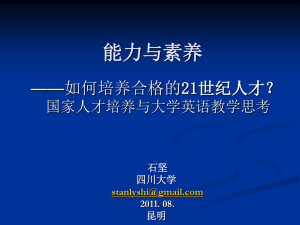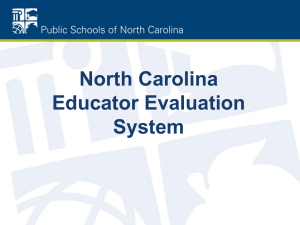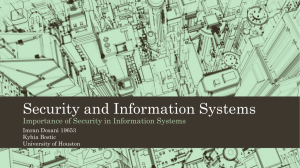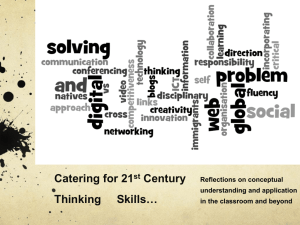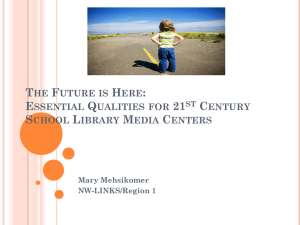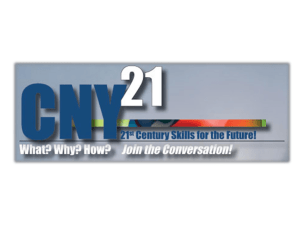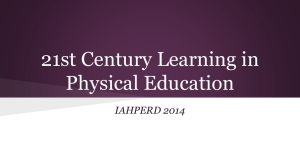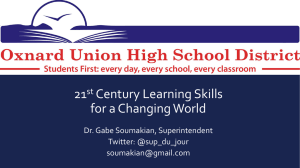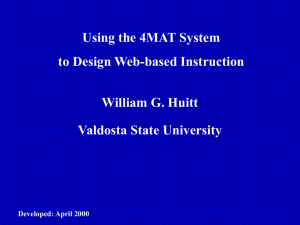Understanding 21st Century Learners
advertisement
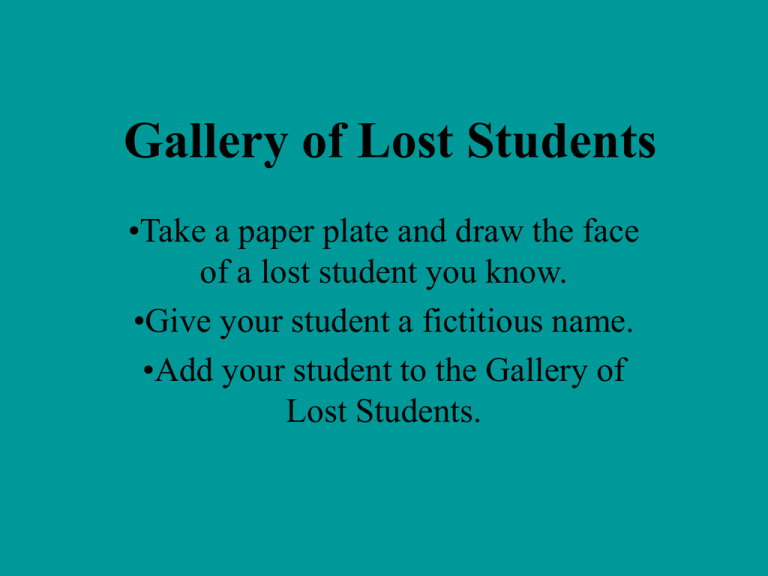
Gallery of Lost Students •Take a paper plate and draw the face of a lost student you know. •Give your student a fictitious name. •Add your student to the Gallery of Lost Students. Understanding 21st Century Learners Jan S. Zuehlke, Ph.D. ZuehlkeJL@aol.com Are children’s brains different today? Kids are different today. Hawkins, M. L. & Graham, M. D. Curriculum architecture: Creating a place of our own. National Middle School Association, 1994. Not because of their clothes or their secret codes or their music. Hawkins, M. L. & Graham, M. D. Curriculum architecture: Creating a place of our own. National Middle School Association, 1994. They are different because of some basic physiological phenomena. Hawkins, M. L. & Graham, M. D. Curriculum architecture: Creating a place of our own. National Middle School Association, 1994. Kids react while the older generation reflects. Hawkins, M. L. & Graham, M. D. Curriculum architecture: Creating a place of our own. National Middle School Association, 1994. They are random while we are sequential. They are holistic while we are linear. Hawkins, M. L. & Graham, M. D. Curriculum architecture: Creating a place of our own. National Middle School Association, 1994. Their predominant sense is motion and touch whereas ours is hearing and seeing. Hawkins, M. L. & Graham, M. D. Curriculum architecture: Creating a place of our own. National Middle School Association, 1994. As learners, they experience while we intellectualize. Hawkins, M. L. & Graham, M. D. Curriculum architecture: Creating a place of our own. National Middle School Association, 1994. The concern is that schools will not or cannot adjust to these differences in time. Hawkins, M. L. & Graham, M. D. Curriculum architecture: Creating a place of our own. National Middle School Association, 1994. The concern is that we are using the excuse that kids don’t want to learn when, in fact, they do. Hawkins, M. L. & Graham, M. D. Curriculum architecture: Creating a place of our own. National Middle School Association, 1994. They just must learn differently. Hawkins, M. L. & Graham, M. D. Curriculum architecture: Creating a place of our own. National Middle School Association, 1994. How has the world changed in the last 150 years? “It’s hard to imagine any way in which it hasn’t changed. Children know more about what’s going on in the world today than their teachers, often because of the media environment they grow up in. They’re immersed in a media environment of all kinds of stuff that was unheard of 150 years ago, and yet if you look at school today versus 100 years ago, they are more similar than dissimilar.” Peter Senge, Massachusetts Institute of Technology Six Critical Elements for 21st Century Learners 1. 2. 3. 4. 5. 6. Emphasize core subjects Emphasize learning skills Use 21st century tools to develop learning skills Teach and learn in a 21st century context Teach and learn 21st century content Use 21st century assessments that measure 21st century skills Partnership for 21st Century Skills. Learning for the 21st Century. www.21stcenturyskills.org Three Key Learning Skills Information and Communication Skills Thinking and Problem-Solving Sills Interpersonal and Self- Directional Skills Partnership for 21st Century Skills. Learning for the 21st Century. www.21stcenturyskills.org 21st Century Content Global Awareness Financial, Economic, and Business Literacy Civic Literacy Partnership for 21st Century Skills. Learning for the 21st Century. www.21stcenturyskills.org What implication does this have on teaching social studies in the 21st century? Why is it Important to Teach Social Studies? Social studies educators teach students the content knowledge, intellectual skills, and civic values necessary for fulfilling the duties of citizenship in a participatory democracy. National Council of Social Studies Strategies for Success in Social Studies Culture is about a person’s whole way of life. •Culture is learned behavior, not something you are born with. •You learn how to act, feel, and think, as well as how to behave. •You also learn culture through language. •Culture is powerful because it shapes you and who you are. •Cultures can be the same or they can be different. Culture Bag Assignment Thinking about who you are and your culture, create a bag to bring to class to share with your fellow classmates. You can use a clear baggie or create your own special bag. Put pictures or artifacts in the bag that represent you and your culture. What country dressed you today? • Find someone you don’t know and introduce yourself. • Look at the label in one article of clothing you wore today. • What country made this garment? • Talk to your new friend about the country. “Coathanger Concepts” Objective: To help students build “folders” or concepts to have a place to “hang” the facts as they progress through the grades. Pick a Concept from the TEKS • • • • Freedom Democracy Citizenship Agriculture • • • • Transportation Systems Immigration Inventions Materials Needed: Wire Coathangers Construction Paper Markers Scissors Glue Yarn Old Magazines Directions: 1. Select a concept from the TEKS and brainstorm it’s meaning. 2. Define the concept (in “kid” language). 3. Find some examples/non-examples of the concept. 4. State the historical significance of the concept 5. State the general significance or overall importance of the concept Put the information about your concept on construction paper cut outs and attach to a coathanger to make a mobile. Display from the ceiling in the classroom. Concept Definition Examples/ Non-examples Historical Significance General Significance Freedom Freedom means I have the right to do what I want to, within limits. Examples of Freedom Historical S ignificance Constitution Bill of Rights Declaration of Independence P atriotic Songs P atriotic Symbols *Right to pray, speak, and write *Right to vote *Right to be free to do what we want to, within limits General S ignificance I live in a country where I have alot of freedom thanks to the documents my forefathers wrote. Interactive Student Notebook Preview (Hook) Notes (Line) *allows students to reflect upon or *students create or contribute to the experience something that connects directly to the content or thought process that will be addressed in the right side notes *is engaging, interesting, and thoughtprovoking *is open-ended *is quick (3 to 4 minutes), does not have to be completely finished. content of the notes *notes are organized in ways that make them engaging and easy to understand *model for students how to think graphically or use outlines *the note-taking itself involves processing information Processing (Sinker) *cannot be completed successfully unless the information from the right side notes is used *requires thinking beyond the recall level *is engaging, challenging, and interesting *can be completed after class Avoid: *having students copy notes off the overhead, board, or out of the textbook *giving students a page to paste in as right side notes when there is no students involvement with the page Adapted from History Alive! HOOK-LINE-SINKER • The “Hook” is an activity that taps students’ prior knowledge. • The “Line” consists of class notes or other information given to the students by the teacher. • The “Sinker” is any activity or performance assessment that allows students to process what they have learned. Resources for Teaching in the 21st Century • • • • History Alive Mini-Society Project CRISS Thinking Maps How Do You Learn? Check the statements that apply to you. Adapted from The 4MAT System, About Learning Are you a Type One Learner? They learn by feeling their experiences. They take time to reflect and ponder their experience. They learn primarily in dialogue, by listening and sharing ideas. They excel in viewing ideas from many perspectives. They have highly developed imaginations. They thrive on lots of reflecting time, especially when pondering new ideas. They tackle problems by reflecting alone and then brainstorming with others. Their favorite question is “Why?” Adapted from The 4MAT System, About Learning Are you a Type Two Learner? They learn by thinking through experiences, judging the accuracy of what they encounter, examining details and specifics. They take the time to reflect and ponder on what they experience. They excel in traditional learning environments and are thorough and industrious. They look for structure. They thrive on stimulating lectures and readings. They are systematic. They tackle problems with logic and analysis. Their favorite question is “What?” Adapted from The 4MAT System, About Learning Are you a Type Three Learner? They learn by thinking through their experiences, judging the usefulness of what they encounter. They take the time to figure out what can be done with what they learn. They excel at down-to-earth problem solving, often tinkering to make things work. They seek to get to the heart of things. They work for deadlines and “keep to the plan.” They like to be considered competent. They tackle problems quickly, often without consulting others. Their favorite question is “How does this work?” Adapted from The 4MAT System, About Learning Are you a Type Four Learner? They learn from their perceptions and the results of their experiences. They are open to all manner of sensory input. They consider the possibilities of what they learn. They learn primarily through self-discovery. They excel at synthesizing. They are flexible and flourish in challenging situations. They thrive on chaotic situations. They tackle problems with their intuition. Their favorite question is “What If?” Adapted from The 4MAT System, About Learning So What? What If? Why? How? What? Hook S I So What? What If? Why? How? What? N K E R Line Adapted from The 4MAT System, About Learning Window Paning for Retention “A” “Z” 6 WII-FM People tend to remember best… • • • • • • • What they hear first What they hear last In chunks By linking Unusual things that stand out If they review content 6 times If they write it down Window Paning for Retention A child is a person who is going to carry on what you have started. He is going to sit where you are sitting, and when you are gone, attend to those things which you think are important. You may adopt all the policies you please, but how they are carried out depends on him. He will assume control of your cities, states, and nations. He is going to take over your churches, schools, universities, and corporations… …the fate of humanity is in his hands. You have an awesome responsibility to make sure that students have access to social studies instruction every day…because Our greatest contribution to mankind is to make sure there is a teacher in every classroom every day who cares that every student learns and grows and feels like a real human being.
